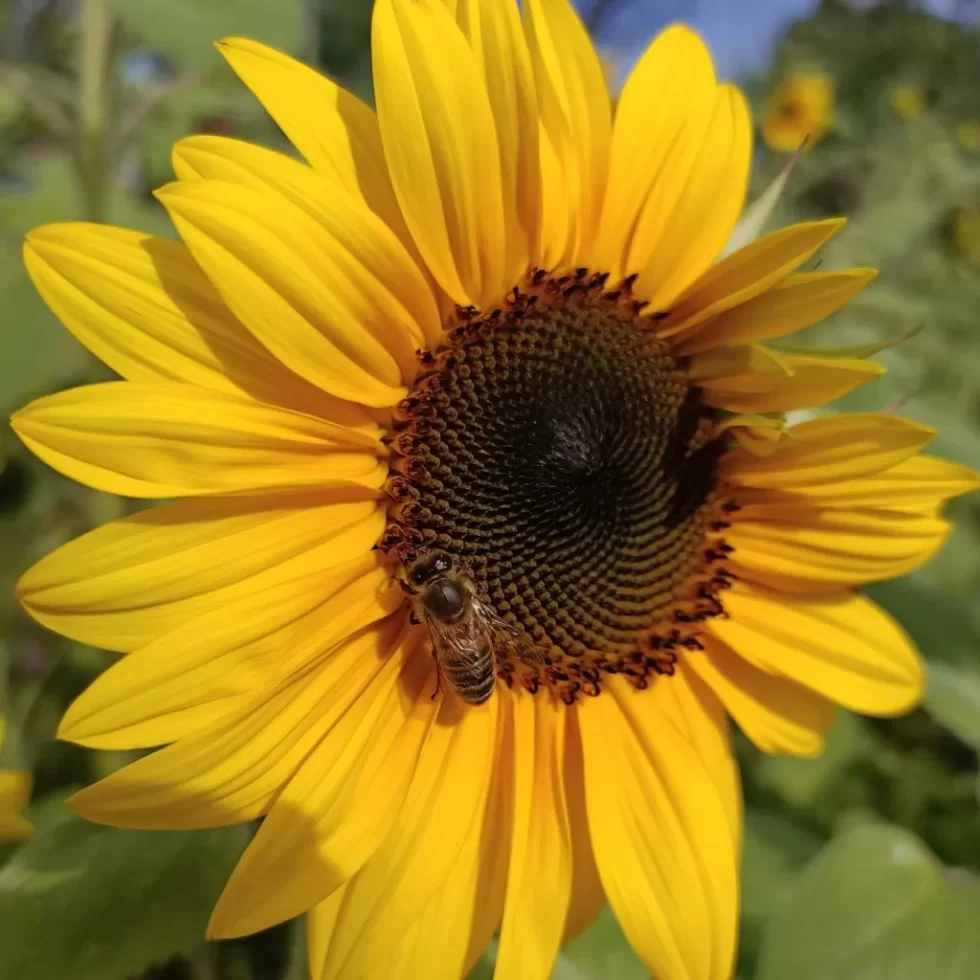SUNFLOWERS
Advice from a sunflower. Be bright, sunny and positive. Know your roots. Spread seeds of happiness. Rise, shine and hold your head up high. Keep on growing. Even on the darkest days, stand tall and find the sunlight.
– source unknown
HISTORICAL INFORMATION
Sunflowers come from north America. They have been cultivated as a crop by the indigenous people for over 4,000 years.1 The seeds were eaten whole, cracked or ground to make flour.
Original sunflower plants were multi-stemmed and bushy. They were selectively bred by the indigenous people of north America to have single stem, thus fitting many more plants in a smaller area.1 The plants were cultivated for their seeds which were eaten whole, cracked or ground to make flour. Native Americans were also the first to discover that the seed could be pressed for oil, which could then be used for cooking or for medicinal and ceremonial purposes.
DESCRIPTION
Sunflowers are traditionally depicted with one long stem, and a large head made of yellow petals with a dark centre. However, sunflowers come in a range of colours from almost-white, through yellow, gold, orange and red to chocolate-brown.2 The centres are often dark, but they can also be yellow or green!3
Sunflowers are annual plants that come in a range of sizes: the smallest under a metre and the tallest over two metres. They can be single-stemmed or multi-branched.
CULINARY and MEDICINAL USES
As has already been mentioned, sunflower seeds can be eaten whole, cracked or ground for flour or meal. Seeds can be eaten raw or cooked. They can mixed with other seeds to make a type of granola, muesli or za’atar. Cracked and roughly chopped, they can be added to pesto.
Sunflower leaves can be added fresh to salad or cooked like spinach, baked to make green chips or steeped to make tea. Young sunflowers stems can be eaten as celery. Sunflower petals can added to salads or used as a garnish. Sunflower seeds can be used to make sprouts or grow as micro-greens.4 Young buds can be eaten as “artichoke”.
The roots of one particular type of sunflower, the “sun-choke” or ‘Jerusalem artichoke’ can be roasted, steamed, fried, mashed or used to thicken soups.4
Tea made from sunflower leaves has traditionally been used to reduce fevers. Poultices made from the leaves have been used to relieve swelling, sores on the skin and insect bites. The leaves can be harvested as the plant comes into flower and dried for later use. Tea made from the flowers was used to treat malaria or lung complaints. A liquid made from mashing the roots then boiling them was used to treat rheumatic pain.5
OTHER BENEFITS
In flower, sunflowers attract bees and other pollinators. Leaves can be fed to rabbits or poultry. The stems, when dry, are as hard as wood. Burnt, they are an excellent source of garden potash which should be used straight away. Allowing the ash to become wet will cause the potash to be washed away. The plant is useful for drying damp soils because it has the ability absorb large amounts of water.6
HOW TO GROW SUNFLOWERS
Sow seed directly where you want the sunflowers to grow. The soil needs to be deep and rich in organic matter. The plants will benefit from a fortnightly dose of liquid fertiliser. Tall varieties may need staking or some other form of support. Ideally, this will be provided at planting to avoid damaging the root ball later. Different varieties of sunflowers grow to different widths, so be sure to refer to the seed packet for the correct spacing.
Sunflowers come from hot, dry parts of the north American continent. Although their capacity to absorb large amounts of water is well-known, they prefer to grow in a rich, well-drained soil. They do, however, need regular, deep watering. It is better to water in the morning so the plant has time to dry during the day. Roots are susceptible to root rot in wet weather. Leaves, stems and flowers are susceptible to fungal diseases if constantly wet.
When the seed heads begin to develop, they may need protection from birds who will snack on the developing seeds.
SUNFLOWERS IN THE PSW SEEDBANK (your seedbank)
- ‘Double Dazzler’ – brought to Australia from Malta after WWII, yellow semi-double
- ‘Giant Russian – tall variety, 2-3 metres, large heads, yellow petals
- Hi-Sun – about 1.2metres, long yellow petals, yellow centre
- Moonwalker – up to 2.5 metres, multi-branching, yellow petals fade to cream
- Sunbird – up to 2.5 metres, large flowers, short yellow petals, dark centres
The Spring 2022 catalogue is now open for sales and closes on last Monday in November (28 Nov). For postage and handling, there is a charge of $5. For “Click and Collect” at the next PSW or Seed Savers meeting, there is a $2 handling fee.
Please note: seeds are for the use of PSW members only. Please do not order if you are not a member, your order cannot be filled until your membership is paid.
Thank you.
Until next month
Lynne (PSW Seed Savers Team Coordinator and Custodian of the Seed Bank)
DISCLAIMER
This article is for gardening information and general interest only. Being neither a herbalist nor a qualified medical practitioner, I cannot give any medical advice on the use of sunflowers, internally or externally. Readers of this article must do their own research before using sunflowers for any purpose other than as a garden plant.
REFERENCES
- Nuseed Europe, History of the Sunflower
- Lynn Coulter, 13 Crazy-Colorful Sunflowers
- HG-TV, Growing Sunflowers: When to Plant and How to Grow Sunflowers (be wary: US site)
- Green City Growers, Making the Most out of Sunflowers
- Natural Medicinal Herbs, Medicinal Herbs, Sunflower, Helianthus annuus
- Mrs M. Grieve, Botanical: a modern herbal Sunflower

